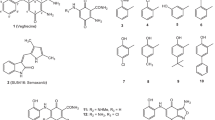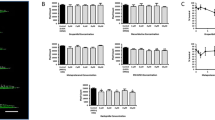Abstract
Angiogenesis depends on vascular endothelial growth factor (VEGF) for initiation and platelet-derived growth factor (PDGF) for maintenance of blood vessels. We have designed a targeted library of compounds from which we identified a novel molecule, GFB-204, that binds PDGF and VEGF, blocks binding of PDGF and VEGF to their receptors (200–500 nM) and subsequently inhibits PDGFR and Flk-1 tyrosine phosphorylation and stimulation of the protein kinases Erk1, Erk2 and Akt and the signal transducer and activator of transcription STAT3. GFB-204 is selective for PDGF and VEGF and does not inhibit EGF, IGF-1 and FGF stimulation of Erk1/2, Akt and STAT3. GFB-204 inhibits endothelial cell migration and capillary network formation in vitro. Finally, treatment of mice with GFB-204 suppresses human tumor growth and angiogenesis. Thus, inhibition of VEGF and PDGF receptor binding with a synthetic molecule results in potent inhibition of angiogenesis and tumorigenesis.
This is a preview of subscription content, access via your institution
Access options
Subscribe to this journal
Receive 50 print issues and online access
$259.00 per year
only $5.18 per issue
Buy this article
- Purchase on Springer Link
- Instant access to full article PDF
Prices may be subject to local taxes which are calculated during checkout



Similar content being viewed by others
References
Andersson M, Ostman A, Kreysing J, Backstrom G, Van de Poll M and Heldin CH . (1995). Growth Factors, 12, 159–164.
Bergers G, Song S, Meyer-Morse N, Bergsland E and Hanahan D . (2003). J. Clin. Invest., 111, 1287–1295.
Blaskovich MA, Lin Q, Delarue FL, Sun J, Park HS, Coppola D, Hamilton AD and Sebti SM . (2000). Nat. Biotechnol., 18, 1065–1070.
Blaskovich MA, Sun J, Cantor A, Turkson J, Jove R and Sebti SM . (2003). Cancer Res., 63, 1270–1279.
Carmeliet P and Jain RK . (2000). Nature, 407, 249–257.
Dvorak HF . (2002). J. Clin. Oncol., 20, 4368–4380.
Dvorak HF, Nagy JA, Feng D, Brown LF and Dvorak AM . (1999). Curr. Top Microbiol. Immunol., 237, 97–132.
Erber R, Thurnher A, Katsen AD, Groth G, Kerger H, Hammes HP, Menger MD, Ullrich A and Vajkoczy P . (2004). FASEB J., 18, 338–340.
Eriksson U and Alitalo K . (1999). Curr. Top Microbiol. Immunol., 237, 41–57.
Ferrara N . (1999). Curr. Top Microbiol. Immunol., 237, 1–30.
Ferrara N . (2002a). Semin. Oncol., 29, 10–14.
Ferrara N . (2002b). Nat. Rev. Cancer, 2, 795–803.
Helmlinger G, Yuan F, Dellian M and Jain RK . (1997). Nat. Med., 3, 177–182.
Holash J, Maisonpierre PC, Compton D, Boland P, Alexander CR, Zagzag D, Yancopoulos GD and Wiegand SJ . (1999). Science, 284, 1994–1998.
Huang J, Frischer JS, Serur A, Kadenhe A, Yokoi A, McCrudden KW, New T, O'Toole K, Zabski S, Rudge JS, Holash J, Yancopoulos GD, Yamashiro DJ and Kandel JJ . (2003). Proc. Natl. Acad. Sci. USA, 100, 7785–7790.
Jain RK . (2002). Semin. Oncol., 29, 3–9.
Kerbel RS . (2000). Carcinogenesis, 21, 505–515.
Laird AD, Vajkoczy P, Shawver LK, Thurnher A, Liang C, Mohammadi M, Schlessinger J, Ullrich A, Hubbard SR, Blake RA, Fong TA, Strawn LM, Sun L, Tang C, Hawtin R, Tang F, Shenoy N, Hirth KP, McMahon G and Cherrington . (2000). Cancer Res., 60, 4152–4160.
Miao RQ, Agata J, Chao L and Chao J . (2002). Blood, 100, 3245–3252.
Morin MJ . (2000). Oncogene, 19, 6574–6583.
Oefner C, D'Arcy A, Winkler FK, Eggimann B and Hosang M . (1992). EMBO J., 11, 3921–3926.
Papadimitriou E, Polykratis A, Courty J, Koolwijk P, Heroult M and Katsoris P . (2001). Biochem. Biophys. Res. Commun., 282, 306–313.
Paris D, Townsend K, Quadros A, Humphrey J, Sun J, Brem S, Wotoczek-Obadia M, DelleDonne A, Patel N, Obregon DF, Crescentini R, Abdullah L, Coppola D, Rojiani AM, Crawford F, Sebti SM and Mullan M . (2004). Angiogenesis, 7, 75–85.
Relf M, LeJeune S, Scott PA, Fox S, Smith K, Leek R, Moghaddam A, Whitehouse R, Bicknell R and Harris AL . (1997). Cancer Res., 57, 963–969.
Sun J, Blaskovich MA, Knowles D, Qian Y, Ohkanda J, Bailey RD, Hamilton AD and Sebti SM . (1999). Cancer Res., 59, 4919–4926.
Wedge SR, Ogilvie DJ, Dukes M, Kendrew J, Curwen JO, Hennequin LF, Thomas AP, Stokes ES, Curry B, Richmond GH and Wadsworth PF . (2000). Cancer Res., 60, 970–975.
Yancopoulos GD, Davis S, Gale NW, Rudge JS, Wiegand SJ and Holash J . (2000). Nature, 407, 242–248.
Zhang W, Ran S, Sambade M, Huang X and Thorpe PE . (2002). Angiogenesis, 5, 35–44.
Acknowledgements
This work was supported by National Institutes of Health grants CA 78038 (SMS and ADH) and GM35208 (ADH).
Author information
Authors and Affiliations
Corresponding authors
Rights and permissions
About this article
Cite this article
Sun, J., Wang, Da., Jain, R. et al. Inhibiting angiogenesis and tumorigenesis by a synthetic molecule that blocks binding of both VEGF and PDGF to their receptors. Oncogene 24, 4701–4709 (2005). https://doi.org/10.1038/sj.onc.1208391
Received:
Accepted:
Published:
Issue Date:
DOI: https://doi.org/10.1038/sj.onc.1208391
Keywords
This article is cited by
-
Calix[4]API-s: fully functionalized calix[4]arene-based facial active pharmaceutical ingredients
Molecular Diversity (2021)
-
In vivo characterization of 68Ga-NOTA-VEGF121 for the imaging of VEGF receptor expression in U87MG tumor xenograft models
European Journal of Nuclear Medicine and Molecular Imaging (2013)
-
Mitochondrial UQCRB regulates VEGFR2 signaling in endothelial cells
Journal of Molecular Medicine (2013)
-
Significantly high expression of platelet-derived growth factor (PDGF) in benign nodules of the thyroid: relevance in the development of goitre recurrence?
Langenbeck's Archives of Surgery (2011)
-
PET imaging of early response to the tyrosine kinase inhibitor ZD4190
European Journal of Nuclear Medicine and Molecular Imaging (2011)



